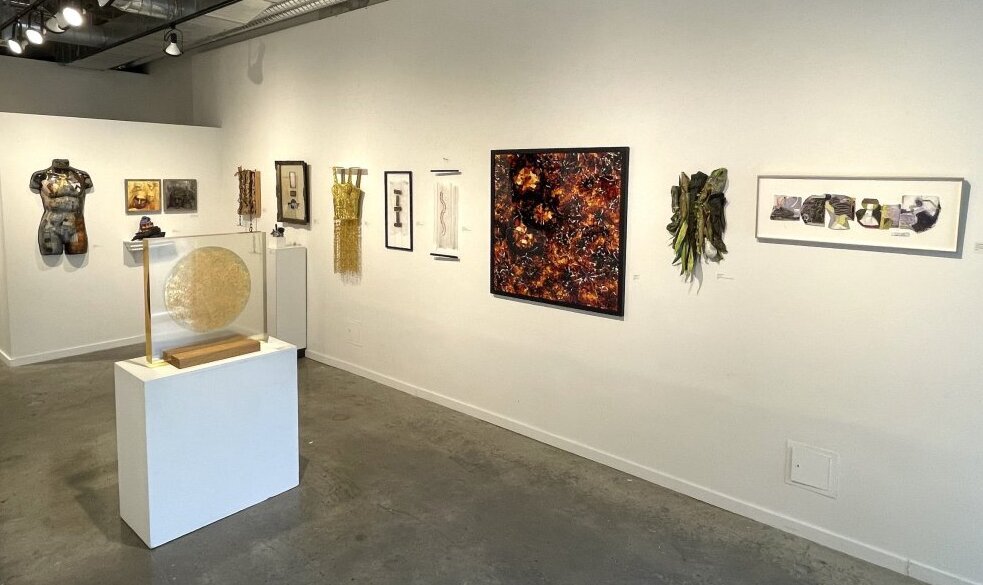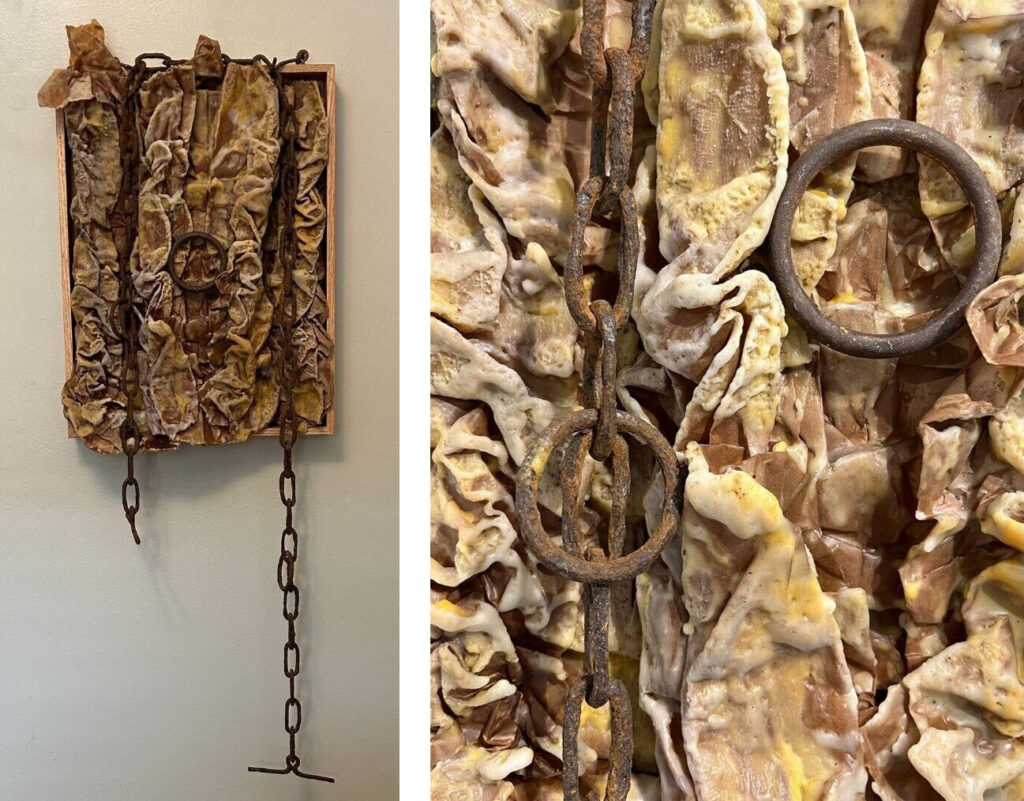I was delighted to explore Experimental Intervention curated by Leisa Rich at Propeller Art Gallery. This bold exhibition focuses on artistic experimentation and the courage required to step beyond familiar techniques or materials. It celebrates risk and reinvention in contemporary art, and challenges artists to push past traditional boundaries, embracing risk and the possibility of failure in pursuit of personal and professional growth. The curator selected works that reflect this journey of creative expansion with innovative narratives and that redefine traditional art-making, encouraging viewers to see art in a new light. By using unconventional materials, exploring new dimensions, and crafting pieces that provoke fresh perspectives, artists can redefine what art can be.
Installation view of Experimental Intervention at Propeller Art Gallery
“Lovers” by Lukas Mouka stood out, due to its large size and interesting narrative. I was drawn to the painting by its strong contrast and meticulous attention to detail, built upon light and darkness. The artist wrote, “When I looked at it closely, the images made a lot of sense; it was like magic where they ended up.” The closer I looked, the more I noticed the seamless blend of cut-up magazine papers and acrylic paint—almost imperceptible at first glance.
The interplay of materials and potentially symbolic imagery creates a narrative that is thought-provoking. One aspect that captivated me was the depiction of men carrying a cross, seemingly emerging from beneath the figures’ legs, which evoked a powerful typological connection for me. This piece truly invites viewers into a layered experience, where each glance reveals new details and connections.
Lukas Mouka, Lovers, collage, acrylic, charcoal, oil on canvas, 30 x 40 x 1 inches (left) and detail (right)
Ruth Maude’s “Remnants of Decay” powerfully engages with themes of environmental degradation and industrial remnants, creating a piece that is both visually compelling and conceptually rich. The artist’s choice of materials—a rusted chain and discarded packaging—infuses the work with an authenticity and rawness that enhance the idea of decay and the persistence of waste. The encaustic-coated packaging and rusted chain break free from traditional two-dimensional constraints, evolving into a three-dimensional sculpture that casts shadows on the wall. Maude notes that it intensifies the tension between natural decay and human-induced degradation, reinforcing the piece’s message. Maude’s method, allowing the materials to dictate the form, effectively mirrors nature’s own processes of decomposition. The sculptural quality of the work breaks beyond traditional flat surfaces, allowing the viewer to engage with it from multiple angles and perspectives. Maude’s work beautifully encapsulates the dialogue between the environment and destruction, making it a powerful commentary on the consequences of human consumption.
Ruth Maude, Remnants of Decay, mixed media: encaustic and rusty chain on paper packaging, 36 x 13.5 x 4.5 inches (left) and detail (right)
Natalja Heybroek’s work demonstrates a fascinating exploration of both materiality and perception, bringing together traditional elements like wood and glass with modern mediums like epoxy resin to create eye-catching effects. Through the use of transparency, reflection, and intricate organic shapes, Heybroek achieves a depth that invites viewers to look beyond surface appearances. Details, such as ink drips and curled wood shavings, draws attention to the artwork’s organic roots, even as it ventures into abstract, otherworldly motives. This piece stands out with its vibrant colours and intricate details. The farther away you stand from the artwork, the clearer the larger picture becomes. “The Edge”, inspired by black holes, questions the nature of perception and explores the boundaries of human understanding and the illusions created by our senses. By addressing themes that blend science, philosophy, and nature, Heybroek’s work offers a powerful reminder of our limitations and the relativity of our realities. The artist’s integration of complex visual elements with profound concepts about perception and the unknown transforms her pieces into meditative experiences, encouraging viewers to ponder the extent of human knowledge.
Natalja Heybroek, The Edge, ink, and epoxy, 38 x 38 x 1.25 inches (left) and detail (right)
Each work in Experimental Intervention reflects a journey of creative exploration. Rich’s curation stands out, inviting deeper engagement with each piece.
Kaya Meziane
Images are courtesy of Propeller Art Gallery
*Exhibition information: Experimental Intervention / Group show, October 23 – November 10, 2024, Propeller Art Gallery, 30 Abell St, Toronto. Gallery hours: Wed – Sat, 1 – 5:30pm, Sun 12 – 4pm.





Great article! Thank you!
Thank you so much for this thoughtful review! The pieces in Experimental Intervention are strong and varied. What an honour it was for me to curate this exhibition. I have to also thank Propeller for giving me this chance, as a Canadian only recently returned to my home country, Canada!